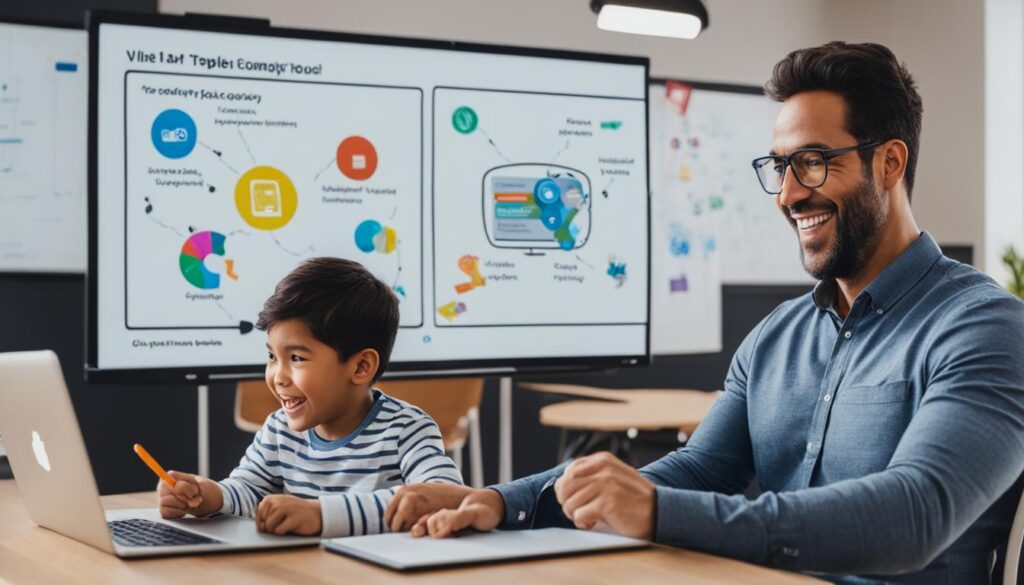The widespread adoption of smartphones and the rise of social media have introduced new challenges to parenting. Technology has significantly impacted parenting, and it is important to understand how information technology impacts parenting issues. According to a Pew Research Center survey, 66% of parents in the United States believe that parenting is harder today than it was 20 years ago, with many citing technology as a reason.
Parents have concerns about screen time, online safety, cyberbullying, and the long-term effects of smartphones on children’s development. It is crucial for parents to be aware of the impact technology has on parenting and equip themselves with the necessary tools to navigate these challenges.
Contents
- 1 Parental Concerns about Screen Time
- 2 Online Safety and Cyberbullying
- 3 Parenting in the Age of Technology
- 4 Technology’s Influence on Child Development
- 5 Digital Parenting Tips
- 6 Conclusion
- 7 FAQ
- 7.1 How does information technology impact parenting issues?
- 7.2 What are parents’ concerns about screen time?
- 7.3 How can parents ensure online safety and handle cyberbullying?
- 7.4 What are the challenges of parenting in the age of technology?
- 7.5 How does technology influence child development?
- 7.6 What are some digital parenting tips?
- 7.7 How does technology impact parent-child relationships?
- 7.8 What should parents do in the age of technology?
- 8 Source Links
Key Takeaways:
- Technology has made parenting more challenging, according to 66% of parents surveyed.
- Parents have concerns about screen time, online safety, cyberbullying, and the long-term effects of smartphones on children’s development.
- Understanding the impact of technology on parenting is crucial for creating a healthier digital environment for children.
- By staying informed, setting boundaries, and fostering open communication, parents can effectively navigate the challenges posed by technology.
- Finding the right balance between technology use and offline experiences is essential for optimizing child development in the digital age.
Parental Concerns about Screen Time
Nearly 71% of parents of children under the age of 12 are concerned about their child spending too much time in front of screens. As technology becomes increasingly prevalent in our lives, managing screen time for kids has become a significant concern for parents. While you may feel confident in your ability to determine the appropriate amount of screen time for your child, seeking advice from doctors, other parents, and teachers can provide valuable insights and strategies. This collaborative approach allows you to gather a range of perspectives and make informed decisions about your child’s technology use.
Understanding the potential impact of excessive screen time, the World Health Organization has issued guidelines on screen time for young children. These guidelines aim to strike a balance between the benefits and risks of technology use, promoting healthy child development while minimizing potential harm. It’s essential to stay informed about these recommendations, as they contribute to the ongoing discussion and concerns surrounding screen time.
“It is not about completely eliminating screen time, but rather managing it effectively and ensuring a healthy balance of other activities.”
By implementing effective strategies to manage screen time, you can create a healthy digital environment for your child. Here are some technology and parenting strategies to consider:
1. Set Clear Boundaries
Establish clear rules and boundaries around screen time. Communicate these expectations to your child and enforce them consistently. For example, you might designate specific times of the day for screen use or set limits on the duration of each session.
2. Encourage Alternative Activities
Encourage your child to engage in a variety of different activities beyond screen time. Encourage outdoor play, reading, arts and crafts, and social interactions. By providing alternative forms of entertainment and stimulation, you can help reduce reliance on screens.
3. Model Healthy Technology Use
Children learn by observation, so it’s important to model healthy technology use yourself. Limit your own screen time when interacting with your child, and prioritize spending quality time together without distractions. By demonstrating a balanced approach to technology, you can positively influence your child’s behavior.
4. Foster Open Communication
Encourage your child to talk about their experiences with technology. Create an open and non-judgmental environment where they feel comfortable discussing any concerns or issues that arise online. By fostering open communication, you can address potential risks and guide your child towards safe online behavior.
5. Stay Informed
Technology is constantly evolving. Stay informed about the latest trends, apps, and platforms that your child is using. Regularly review privacy settings and familiarize yourself with parental control features to ensure your child’s safety and well-being online.
By implementing these strategies, you can effectively manage screen time for your child and promote a healthy balance between technology use and other activities. Remember, managing screen time is not about completely eliminating it but rather finding a harmonious approach that supports your child’s overall development.
Online Safety and Cyberbullying
As a parent, one of your top priorities is ensuring the online safety of your children. The digital world poses potential risks and dangers that you need to be aware of and address. With the increasing use of digital devices, it becomes crucial to educate yourself about online safety measures and implement them to protect your children.
The Risks of the Digital World
The internet provides limitless possibilities for learning, entertainment, and connection, but it also exposes children to cyberbullying and other online threats. Cyberbullying has become a significant concern for parents as it can have a detrimental impact on a child’s well-being. It is important to be vigilant and proactive in preventing cyberbullying incidents and addressing them effectively when they occur.
Safeguarding Your Child
Here are some practical steps you can take to protect your child from online threats:
- Establish clear rules and boundaries for internet use
- Monitor your child’s online activities and maintain open communication
- Teach your child about online safety, including the importance of privacy and responsible behavior
- Encourage them to report any instances of cyberbullying or inappropriate online behavior
- Stay informed about the latest trends and technologies
The Role of Education and Awareness
Part of ensuring online safety for children involves educating yourself about the risks and teaching your child about responsible online behavior. By discussing the potential dangers and fostering an open and trusting relationship, you can empower your child to make informed decisions and navigate the digital world safely.
“The best way to protect your child online is through open communication and guidance. By establishing trust and setting clear expectations, you can help your child develop responsible digital habits.” – Dr. Sarah Thompson, Child Psychologist
| Online Safety Tips | Cyberbullying Prevention Strategies |
|---|---|
| 1. Talk to your child about the importance of privacy settings and not sharing personal information online. | 1. Teach your child about empathy and kindness, encouraging them to stand up against cyberbullying. |
| 2. Install and update parental control software to filter inappropriate content and limit screen time. | 2. Help your child develop resilience by discussing strategies to handle cyberbullying situations. |
| 3. Regularly discuss online safety and remind your child about the potential risks and dangers. | 3. Monitor your child’s online presence and social media accounts to identify signs of cyberbullying. |
By implementing these measures and staying actively involved in your child’s online activities, you can create a safer digital environment and protect them from cyberbullying and other online threats.
Parenting in the Age of Technology
The rapid advancement of technology has brought about a whole new set of challenges for parents. In today’s digital age, parenting is no longer limited to traditional concerns but also encompasses the intricate digital landscape. The easy access to information, widespread use of social media, and the significant influence of digital devices on children’s behavior and development have all contributed to these complexities. As a parent, it is essential to navigate these challenges effectively to ensure the well-being and healthy development of your children.
Digital parenting presents a unique set of challenges that were unheard of in the past. The increasing prevalence of smartphones and other digital devices means that children are exposed to technology from a very young age. This presents parents with the task of finding the right balance between allowing their children to benefit from technology while minimizing the potential hazards and negative impacts. As a parent, it can be overwhelming to stay informed, adapt to new technologies, and ensure responsible use of digital devices.
One of the main digital parenting challenges is managing screen time. With an increasing number of devices and platforms vying for a child’s attention, it can be challenging to set limits and enforce them effectively. Parents are concerned about the potential detrimental effects of excessive screen time on their children’s physical and mental well-being. Striking a balance between the benefits of technology and the need for physical activities, face-to-face interactions, and outdoor play is vital.

Screen Time Recommendations by Age
| Age Group | Recommended Screen Time |
|---|---|
| 0-18 months | Avoid screen time (except video chatting) |
| 18-24 months | Introduce high-quality educational content, limited and supervised |
| 2-5 years | No more than 1 hour of high-quality educational content per day, supervised |
| 6-10 years | 1-2 hours of consistent and supervised screen time |
| 11-13 years | 1-2 hours for academic and recreational purposes, with a balance |
Online safety and cyberbullying are also pressing concerns for digital parents. The internet can be a dangerous place for children, with potential risks ranging from exposure to inappropriate content to online predators. Parents must educate themselves about online safety measures, monitor their child’s online activities, and have open and honest conversations about the risks associated with the online world.
The rise in cyberbullying and the adverse effects it can have on a child’s well-being have only exacerbated parental concerns. As cyberbullying can happen discreetly and outside of parental control, it is critical to equip children with the tools and knowledge to prevent and report such incidents. Parental involvement, fostering trust, and creating a safe space for children to share their experiences are essential components of combating cyberbullying.
Parenting in the age of technology requires a proactive and informed approach. Staying updated on the latest technological trends, seeking guidance from experts, and connecting with other parents facing similar challenges can be immensely helpful. It is crucial to maintain an open line of communication with your children, teaching them responsible digital behavior and modeling it yourself.
No one is born a perfect digital parent. It is a continuous learning process, and mistakes will be made. The key is to adapt, educate, and communicate with your children.
By acknowledging and proactively addressing the challenges posed by technology, parents can create a healthy and nurturing digital environment for their children. Embracing the benefits of technology while establishing boundaries and fostering open communication will enable parents to navigate the complexities of modern parenting successfully.
Technology’s Influence on Child Development
The use of digital devices has become common among children of all ages. This exposure may have both positive and negative effects on child development. While digital devices can provide educational opportunities and entertainment, concerns exist about the potential harm caused by excessive screen time. Parents are aware of the potential risks and weigh the benefits and drawbacks of technology in their children’s lives.
On one hand, technology has the potential to enhance child development. Educational apps and online resources can provide children with access to a wide range of information and interactive learning experiences. These digital tools can foster cognitive development, improve problem-solving skills, and promote creativity. Additionally, technology can facilitate communication and social interaction, helping children stay connected with friends and family members.
However, there are valid concerns about the negative impact of technology on child development. Excessive screen time, particularly for young children, has been associated with sleep disturbances, language delays, and reduced physical activity. The constant exposure to screen-based media may hinder the development of important social and emotional skills, such as empathy and self-regulation. It is essential for parents to strike a balance and ensure that their children’s screen time is appropriate and well-regulated.

To better understand the potential effects of technology on child development, let’s take a closer look at both the positive and negative aspects:
| Positive Influences | Negative Influences |
|---|---|
|
|
As parents, it is crucial to carefully manage and monitor your child’s technology use. Setting limits on screen time, encouraging offline activities, and ensuring age-appropriate content can help mitigate the potential negative effects of technology. By fostering a healthy balance between technology and other aspects of life, you can support your child’s overall development and well-being.
“It’s important to strike a balance between technology use and other activities to support children’s healthy development.” – Dr. Emily Roberts, Child Psychologist
Digital Parenting Tips
To effectively navigate the challenges posed by technology, you can employ various strategies for digital parenting success. By implementing these digital parenting tips, you can create a safer and healthier digital environment for your children.
1. Set Clear Rules and Boundaries
Establishing clear rules and boundaries around screen time is essential for managing your child’s digital use. Set specific limits on the amount of time they can spend on devices and establish guidelines for when and where devices can be used. Consistency is key to ensure that your child understands and respects these boundaries.
2. Monitor Online Activities
Regularly monitor your child’s online activities to ensure their safety and well-being. Familiarize yourself with the platforms and apps they use, and consider using parental control software to block inappropriate content. Keep an open line of communication with your child and explain the importance of responsible online behavior.
3. Foster Open Communication
Encourage open communication with your children about technology. Talk to them about the potential risks and consequences of certain online activities, such as sharing personal information or engaging with strangers. Create a safe and non-judgmental space where they feel comfortable discussing their online experiences and seeking your guidance when needed.
“Open communication is crucial in building trust with your child. By fostering a supportive environment, you can help them navigate the digital world with confidence.”
4. Stay Informed About the Latest Trends and Risks
Keep yourself updated on the latest digital trends and the potential risks they may pose to your child’s safety. Stay informed about new social media platforms, online games, and communication tools to better understand the digital landscape your child is navigating. This knowledge will help you address any emerging challenges effectively.
By following these digital parenting tips, you can guide your child through the intricacies of the digital age while ensuring their well-being and healthy development.

By setting boundaries around technology use, parents can create opportunities for meaningful connections. Designated tech-free times, such as family meals, bedtime routines, or outings, provide valuable opportunities for open communication, socialization, and emotional bonding.
Additionally, parents can leverage technology as a tool to strengthen relationships. Engaging in shared activities like playing interactive games, watching educational videos, or exploring creative apps can foster parent-child connections while embracing the benefits of technology.
“Technology offers immense possibilities for improving and nurturing parent-child relationships. However, it is crucial for parents to strike a balance between screen time and quality family interactions.”
Key Strategies:
- Set clear boundaries around technology use and establish device-free zones or times.
- Engage in activities that encourage interaction and communication, both offline and online.
- Encourage open dialogue about technology and its influence, fostering mutual understanding and learning.
- Lead by example: prioritize device-free time, actively listen, and fully engage in conversations with your child.
“Our research shows that the quality of interactions is far more important than the quantity of time spent. Being present and engaged in your child’s life, both online and offline, is the key to building and maintaining strong parent-child relationships.”
– Dr. Emily Wilson, Child Development Specialist
| Benefits | Challenges |
|---|---|
| Enhanced communication | Device distractions |
| Access to educational resources | Decreased quality time |
| Opportunities for shared activities | Overdependence on technology |
By embracing technology mindfully and implementing effective parenting strategies, parents can utilize the benefits of technology while preserving and nourishing strong parent-child relationships.
Conclusion
Technology’s impact on parenting is undeniable in the age of technology. As the digital landscape continues to evolve, parents face new challenges that require them to stay informed and adapt their parenting strategies accordingly. From managing screen time to ensuring online safety, parents must navigate the complexities of technology to foster their child’s healthy development.
By finding the right balance between technology use and offline experiences, parents can optimize their child’s well-being in the digital age. Setting clear rules and boundaries around screen time, monitoring online activities, and fostering open communication are essential strategies for successful digital parenting.
It is important for parents to prioritize quality time with their children by limiting their own device distractions. By actively engaging with their children without technological distractions, parents can strengthen their relationships and create a nurturing environment.
In conclusion, technology’s impact on parenting is a continuous journey that requires parents to adapt and make informed choices. By embracing the benefits of technology while mitigating its potential risks, parents can shape a positive and enriching digital experience for their children, ultimately optimizing their development and well-being in the age of technology.
FAQ
How does information technology impact parenting issues?
Information technology introduces new challenges to parenting, including concerns about screen time, online safety, cyberbullying, and the long-term effects of smartphones on child development.
What are parents’ concerns about screen time?
Nearly 71% of parents of children under 12 are concerned about their child spending too much time in front of screens. Parents seek advice on appropriate screen time from doctors, other parents, and teachers.
How can parents ensure online safety and handle cyberbullying?
Parents are increasingly concerned about their children’s online safety. They seek guidance on protecting their children from online threats and handling instances of cyberbullying.
What are the challenges of parenting in the age of technology?
The rapid advancement of technology has created unique challenges for parents, including the ease of access to information, the prevalence of social media, and the influence of digital devices on children’s behavior and development.
How does technology influence child development?
The use of digital devices can have both positive and negative effects on child development. While they provide educational opportunities and entertainment, concerns exist about the potential harm caused by excessive screen time.
What are some digital parenting tips?
To navigate the challenges of technology, parents can set clear rules and boundaries around screen time, monitor online activities, foster open communication with their children about technology, and stay informed about the latest trends and risks.
How does technology impact parent-child relationships?
Technology can lead to decreased quality time spent with children due to parents’ own device distractions. Parents should be mindful of their technology use and actively engage with their children without distractions.
What should parents do in the age of technology?
Parents must stay informed, adapt to new challenges, and implement effective strategies to navigate the digital landscape. Finding the right balance between technology use and offline experiences is crucial for optimizing child development and well-being.




